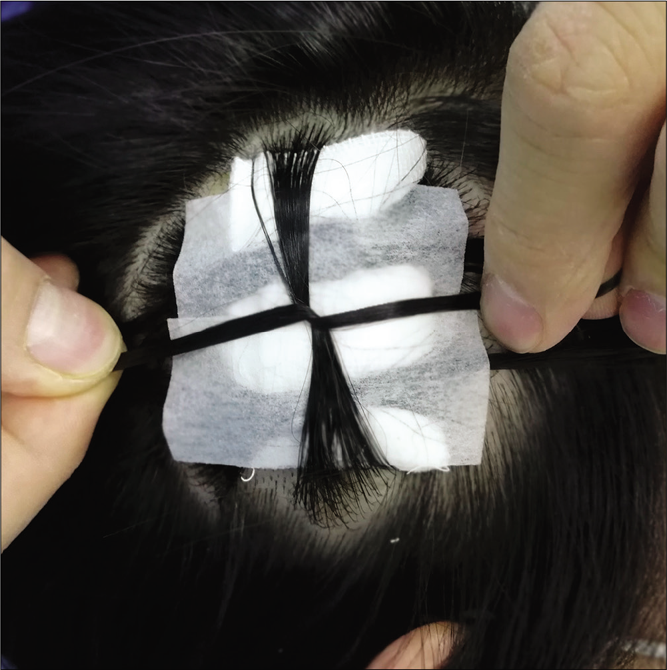Translate this page into:
Cross fixation bandage with long hair on scalp wound after surgery
-
Received: ,
Accepted: ,
How to cite this article: Yang Q, Li E, Pradhan S, Ran Y. Cross fixation bandage with long hair on scalp wound after surgery. Indian J Dermatol Venereol Leprol 2021;87:306-8.
Problem
A scalp bearing long hair tends to loosen the pressure dressings and contaminate the wound after a surgical incision because of a lack of cohesion of the bandage in the hairy skin. Moreover, the use of traditional roller bandage dressing on the scalp is not aesthetically pleasing and easily has a tendency to slip easily because of friction.
Solution
The hair was shaved off to a diameter of 3 to 5 cm around the lesion with a single-edged razor blade [Figure 1a]. After wound closure with suture and disinfection, the wound was covered with sterile gauze, depending on the wound size, to minimize bleeding and exert pressure [Figure 1b]. Then, two strands of hair in bundles (about 200–300 hair each) were twisted and crossed across opposing edges of the wound maintaining adequate tension [Figure 1c]. Medical adhesive tape was stuck upon the hair bundles to prevent the loosening of the dressing [Figure 1d]. Subsequently, repeated cross fixation of hair as described above was placed parallel to and at an interval of 1.5 cm from the previous fixation [Figures 1e and f]. The number of cross fixations depends on the length of the surgical incision. Finally, the last cross fixation was adjusted perpendicular to the previous ones to enhance satisfactory pressure on the sterile gauze [Figures 1g and h]. Please see Video 1 for detailed steps of the surgery. The thick absorbent gauze piece under the hair prevented discharge causing matting of this hair. The sterile dressing could be removed after 48 h by moistening the adhesive tape on the dressing with povidone–iodine solution or disinfectant alcohol to allow relatively painless removal of the tape. In addition, slight pressure on the hair around the dressing by hand could avoid painful pulling of hair while removing the adhesive tape.

- The hair was shaved off to a diameter of 3 cm to 5 cm around the lesion on the scalp

- Cover the wound with the appropriate size of sterile gauze piece

- Two strands of hair in bundles (about 200-300 hair each) were twisted and crossed across opposite edges of the wound maintaining adequate tension

- Medical adhesive tape was stuck upon the hair bundles to prevent the loosening of the dressing

- Repeated cross fixation of hair was placed parallel to and at an interval of 1.5 cm from the previous fixation

- Medical adhesive tape was stuck upon the hair bundles to fix the dressing

- Medical adhesive tape was stuck upon the hair bundles

- The last cross fixation was adjusted perpendicular to the previous ones
Our novel technique of scalp dressing can practically reduce the area of shaving needed before scalp surgery in patients with long hair. Moreover, patients are asked to completely wash their hair before coming for surgery to prevent bacterial colonization and reduce the risk of wound infection. Considering the physical comfort of the patient, the hair on the dressing should not be tied too tightly. Our method is suitable for and comparable to traditional roller bandaging technique for small incisions on the scalp. However, traditional roller bandages are more suitable for larger scalp wounds with more bleeding and hematoma risk. The tightened firm gauze on the scalp exerts sufficient pressure on the smaller wound, avoiding hematoma/seroma formation and contamination. This technique is suitable for patients with long enough hair near the incision area for winding and fixation. The length of the hair should exceed the length and diameter of the gauze used. This method involves only minimal manipulation of hair near the surgical site which does not affect daily life and sleep pattern of the patient.
To conclude, this technique is quick, effective, firm, aesthetic and easy to perform; however, care should be taken while removing the dressings to avoid discomfort to the patient.
Declaration of patient consent
The authors certify that they have obtained all appropriate patient consent.
Financial support and sponsorship
Nil.
Conflicts of interest
There are no conflicts of interest.





